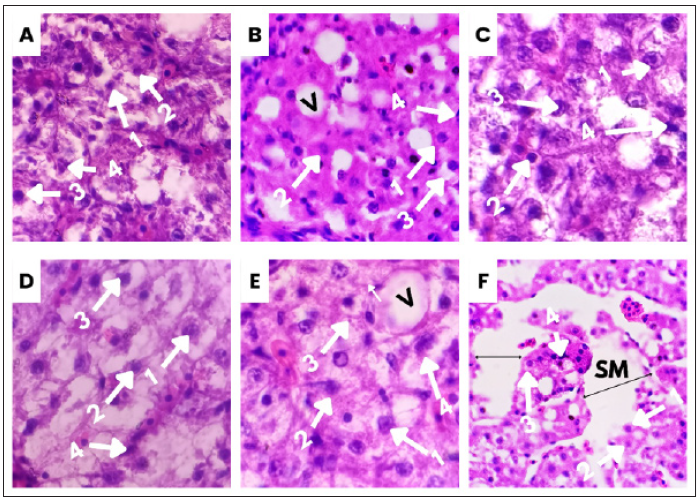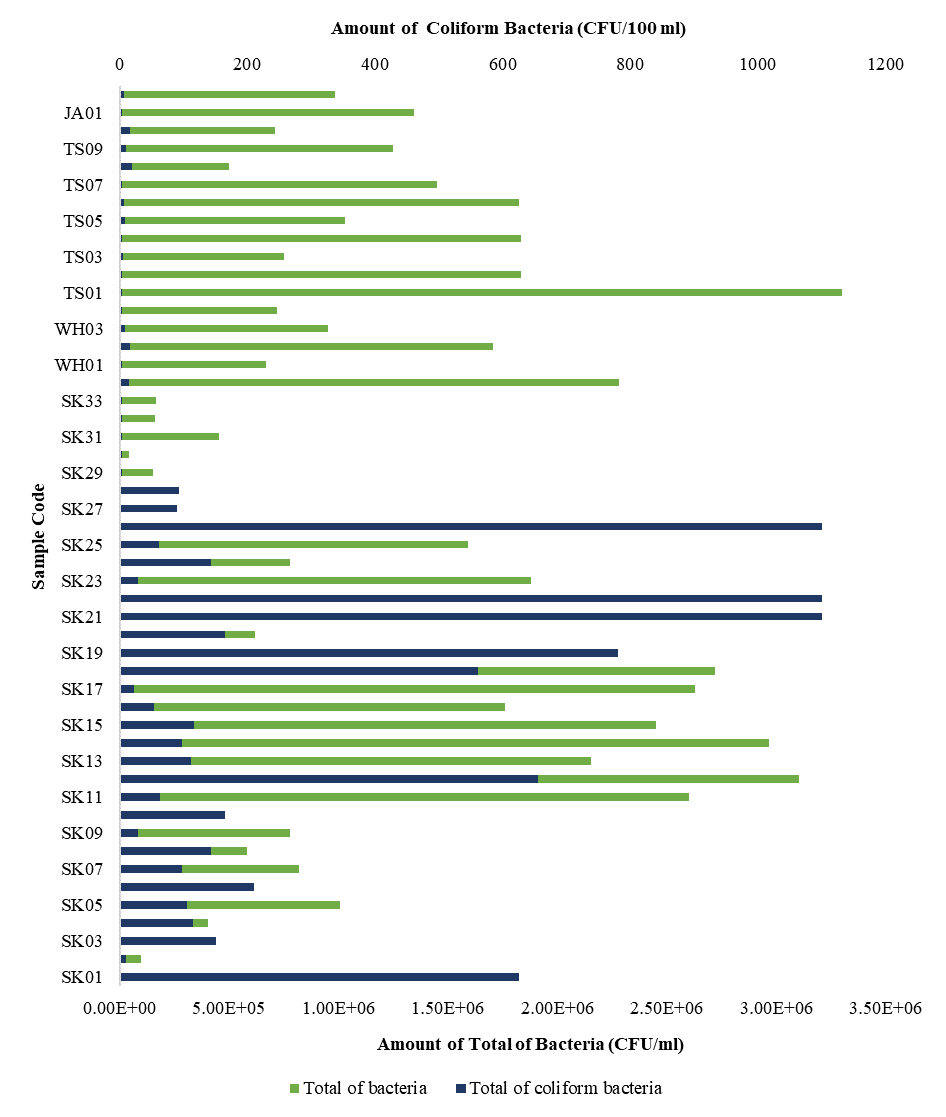Silent Killers: The Alarming Impact of Microplastics Polystyrene on Catfish Liver Health

Introduction: The presence of microplastics in the bodies of living things has become a matter of concern. One example is the widespread use of polystyrene microplastics, which have been widely used by industry even medical products. Styrene bonds and Benzyl Carbon in polystyrene have been identified as potential sources of free radical formation. Upon decomposition, these bonds release dissolved organic carbon, which has been identified as a significant contributor to chemical pollution. Methods: This study aims to determine the effect of microplastic polystyrene in experimental research (MP-PS measuring +0.5 mm) on catfish Clarias gariepinus with concentrations of 1, 1.5, 2, 2.5, 3 mg (K1-K5) for one month on fish liver histopathology. Histopathological observation of fish liver using parrafin method and statistical analysis using SPSS was tested using Anova. Results and Discussion: As determined by the analysis of variance (ANOVA) statistical test (P>0.05), it showed that MP-PS had a significant effect on liver damage in catfish, resulting in the most severe liver damage and the least damage depending on the amount of MP-PS given to the fish. Additional data were obtained in the form of liver tissue abnormalities. Conclusion: The toxicological effects of polystyrene microplastics (MP-PS) on catfish liver health, demonstrating a dose-dependent relationship. Higher MP-PS concentrations led to severe histopathological damage, including several types of liver cell abnormalities. These findings emphasize the urgent need for stricter regulations on microplastic pollution, as its unregulated production threatens aquatic ecosystems and public health.
Muñoz Meneses RA, Cabrera-Papamija G, Machuca-Martínez F, Rodríguez LA, Diosa JE, Mosquera-Vargas E. Plastic Recycling and Their Use as Raw Material for the Synthesis of Carbonaceous Materials. Heliyon. 2022;8(3):e09028. https://doi.org/10.1016/j.heliyon.2022.e09028
Kaandorp MLA, Lobelle D, Kehl C, Dijkstra HA, van Sebille E. Global Mass of Buoyant Marine Plastics Dominated by Large Long-Lived Debris. Nat Geosci. 2023;16(1):689–694. https://doi.org/10.1038/s41561-023-01216-0
Thakur S, Mathur S, Patel S, Paital B. Microplastic Accumulation and Degradation in Environment via Biotechnological Approaches. Water. 2022;14(24):4053. https://doi.org/10.3390/w14244053
Chen MC, Chen TH. Spatial and Seasonal Distribution of Microplastics on Sandy Beaches Along the Coast of the Hengchun Peninsula, Taiwan. Mar Pollut Bull. 2020;151(1):110861. https://doi.org/10.1016/j.marpolbul.2019.110861
Weber A, Jeckel N, Wagner M. Combined Effects of Polystyrene Microplastics and Thermal Stress on the Freshwater Mussel (Dreissena polymorpha). Sci Total Environ. 2020;718(1):137253. https://doi.org/10.1016/j.scitotenv.2020.137253
Siddiqui SA, Singh S, Bahmid NA, Shyu DJH, Domínguez R, Lorenzo JM, et al. Polystyrene Microplastic Particles in the Food Chain: Characteristics and Toxicity. A Review. Sci Total Environ. 2023;892(1):164531. https://doi.org/10.1016/j.scitotenv.2023.164531
Hwang J, Choi D, Han S, Jung SY, Choi J, Hong J. Potential Toxicity Of Polystyrene Microplastic Particles. Sci Rep. 2020;10(1):7391. https://doi.org/10.1038/s41598-020-64464-9
Song YK, Hong SH, Eo S, Han GM, Shim WJ. Rapid Production of Micro- and Nanoplastics by Fragmentation of Expanded Polystyrene Exposed to Sunlight. Environ Sci Technol. 2020;54(1):11191–11200. https://doi.org/10.1021/acs.est.0c02288
Naik RA, Rowles LS, Hossain AI, Yen M, Aldossary RM, Apul OG, et al. Microplastic Particle Versus Fiber Generation During Photo-Transformation in Simulated Seawater. Sci Total Environ. 2020;736(1):139690. https://doi.org/10.1016/j.scitotenv.2020.139690
Ward CP, Armstrong CJ, Walsh AN, Jackson JH, Reddy CM. Sunlight Converts Polystyrene to Carbon Dioxide and Dissolved Organic Carbon. Environ Sci Technol Lett. 2019;6(1):669–674. https://doi.org/10.1021/acs.estlett.9b00532
Song YK, Hong SH, Jang M, Kang J-H, Kwon OY, Han GM, et al. Large Accumulation of Micro-sized Synthetic Polymer Particles in the Sea Surface Microlayer. Environ Sci Technol. 2014;48(16):9014–9021. https://doi.org/10.1021/es501757s
Sulong NHR, Mustapa SAS, Rashid MKA. Application of Expanded Polystyrene (EPS) In Buildings and Constructions: A Review. J Appl Polym Sci. 2019;136(20):1–11. https://doi.org/10.1002/app.47529
Prasittisopin L, Termkhajornkit P, Kim YH. Review of Concrete With Expanded Polystyrene (EPS): Performance and environmental aspects. J Clean Prod. 2022;366(1):132919. https://doi.org/10.1016/j.jclepro.2022.132919
Imron I, Iswanto B, Suparapto R, Marnis H. Development of Genetically Improved Farmed African Catfish, Clarias gariepinus; A Review and Lessons Learned from Indonesian Fish Breeding Program. IOP Conf Ser Earth Environ Sci. 2020;593(1):012032. https://doi.org/10.1088/1755-1315/593/1/012032
Iswanto B, Marnis H, Suprapto R, Imron. Forming the Base Population of Fast-Growing African Catfish (Clarias gariepinus Carrying Major Histocompatibility Complex Class I (MHC I) Allele Through a Within-Family Selection. E3S Web Conf. 2023;442(02006):1-8. https://doi.org/10.1051/e3sconf/202344202006
Sayed AEDH, Hamed M, Badrey AEA, Soliman HAM. Bioremediation of Hemotoxic and Oxidative Stress Induced by Polyethylene Microplastic in Clarias gariepinus Using Lycopene, Citric Acid, and Chlorella. Comp Biochem Physiol Part - C Toxicol Pharmacol. 2021;250(1):109189. https://doi.org/10.1016/j.cbpc.2021.109189
Abarghouei S, Hedayati A, Raeisi M, Hadavand BS, Rezaei H, Abed-Elmdoust A. Size-Dependent Effects of Microplastic on Uptake, Immune System, Related Gene Expression and Histopathology of Goldfish (Carassius auratus). Chemosphere. 2021;276(1):129977. https://doi.org/10.1016/j.chemosphere.2021.129977
Fatema K, Auditi TI, Biswas S, Ayesha SB, Helal Uddin M, Sumon KA, et al. Investigations of Hemato-Biochemical and Histopathological Parameters, and Growth Performance of Walking Catfish (Clarias Batrachus) Exposed to PET And LDPE Microplastics. Environ Toxicol Pharmacol. 2023;102:104250. https://doi.org/10.1016/j.etap.2023.104250
Chazal F, Michel B. An Introduction to Topological Data Analysis: Fundamental and Practical Aspects for Data Scientists. Front Artif Intell. 2021;4(667963):1–28. https://doi.org/10.3389/frai.2021.667963
Abdel-Aziz MFA, Hassan HU, Yones A-M, Abdel-Tawwab YA, Metwalli AAAA-T. Assessing the Effect of Different Feeding Frequencies Combined with Stocking Density, Initial Weight, and Dietary Protein Ratio on the Growth Performance of Tilapia, Catfish and Carp. Sci African. 2021;12(1):e00806. https://doi.org/10.1016/j.sciaf.2021.e00806
Zhao J, Wen Y, Zhu S, Ye J, Zhu J, Ye Z, et al. Solving Post-Prandial Reduction In Performance by Adaptive Regurgitation In A Freshwater Fish. Proc R Soc B Biol Sci. 2020;287(1):2172. https://doi.org/10.1098/rspb.2020.2172
Akinjogunla VF, Usman MD, Muazu TA, Ajeigbe SO, Musa ZA, Ijoh BB, et al. Comparative Efficacy of Anesthetic Agents (Clove Oil and Sodium Bicarbonate) on Cultured African Catfish, Clarias gariepinus (Burchell, 1822) and Nile Tilapia, Oreochromis niloticus (Linnaeus, 1758). Trop J Nat Prod Res. 2023;7(8):3800–3805. https://doi.org/10.26538/tjnpr/v7i8.34
Shkil F, Kapitanova D, Borisov V, Veretennikov N, Roux N, Laudet V. Direct Development of the Catfish Pectoral Fin: An Alternative Pectoral Fin Pattern of Teleosts. Dev Dyn. 2022;251(11):1816–1833. https://doi.org/10.1002/dvdy.509
Moawad U, Awaad A, Tawfiek M. Histomorphological, Histochemical, And Ultrastructural Studies on the Stomach of the Adult African Catfish (Clarias gariepinus). J Microsc Ultrastruct. 2017;5(3):155-166. https://doi.org/10.1016/j.jmau.2016.08.002
Kari ZA, Sukri SAM, Téllez-Isaías G, Bottje WG, Khoo MI, Guru A, et al. Effects of Dietary Powdered Ficus Deltoidea on the Growth and Health Performance of African Catfish, Clarias Gariepinus Production. Fish Physiol Biochem. 2024;50(1):2563–2582. https://pubmed.ncbi.nlm.nih.gov/30023250/
Ilyas S, Tanjung M, Nurwahyuni I, Pasaribu FY. Effect of Mahkota Dewa Ethanolic Extracts (Phaleria macrocarpa Scheff.) to Hepar Histology of Female Rat (Rattus novergicus) In Preeclampsia. IOP Conf Ser Earth Environ Sci. 2019;305(1):012075. https://doi.org/10.1088/1755-1315/305/1/012075
Sabri E, Ilyas S, Prasetiawan E. The Effect Of N-Hexane Extract Of Andaliman ( Zanthoxylum acanthopodium DC.) Fruit in the Liver Tissues of Mice During Post Implantation of Pregnancy. J Phys Conf Ser. 2018;1116(1):052056. https://doi.org/10.1088/1742-6596/1116/5/052056
Iswari RS, Dafip M, Rifa’i M. Biochemical and Histopathology Analysis of Liver Damage in Hypercholesterolemic Rats Induced by Tomato Extract. Biosaintifika. 2020;12(3):438–445. https://journal.unnes.ac.id/nju/biosaintifika/article/view/23337
Schulze RJ, Schott MB, Casey CA, Tuma PL, McNiven MA. The Cell Biology of the Hepatocyte: A Membrane Trafficking Machine. J Cell Biol. 2019;218(7):2096–2112. https://doi.org/10.1083/jcb.201903090
Craig CF. Essentials of Pathology. Am J Trop Med Hyg. 1943;s1-23(4):473–474. https://doi.org/10.4269/ajtmh.1943.s1-23.473
Mohammadinejad R, Moosavi MA, Tavakol S, Vardar DÖ, Hosseini A, Rahmati M, et al. Necrotic, Apoptotic And Autophagic Cell Fates Triggered By Nanoparticles. Autophagy. 2019;15(1):4–33. https://doi.org/10.1080/15548627.2018.1509171
Istikhomah, Lisdiana. Efek Hepatoprotektor Ekstrak Buah Pedada (Sonneratia caseolaris) pada Tikus Putih (Rattus norvegicus). Unnes J Life Sci. 2015;4(1):1–8. https://doi.org/https://journal.unnes.ac.id/sju/UnnesJLifeSci/article/view/12205.
Liu N, Guan Y, Zhou C, Wang Y, Ma Z, Yao S. Pulmonary and Systemic Toxicity in a Rat Model of Pulmonary Alveolar Proteinosis Induced by Indium-Tin Oxide Nanoparticles. Int J Nanomedicine. 2022;17(1):713–731. https://doi.org/10.2147/IJN.S338955
Saraswati I, Armalina D, Ayu FR, Purnawati RD. Effect of Tiger Shrimp Shell Extract (Penaeus monodon) on Monosodium Glutamate-Induced Mice. J Kedokt Diponegoro (Diponegoro Med Journal). 2023;12(3):150–166. https://doi.org/10.14710/dmj.v12i3.38767
Purkon DB, Kusmiyati M, Trinovani E, Fadhlillah FM, Widyastiwi W, Roseno MH, et al. The Hepatoprotective Effect of Marchantia Paleacea Bertol. Extract Against Acetaminophen-Induced Liver Damage in Rat: Biochemical and Histological Evidence. J Res Pharm. 2022;26(6):1857–1867. https://doi.org/10.29228/jrp.275
Hamed M, Soliman HAM, Badrey AEA, Osman AGM. Microplastics Induced Histopathological Lesions in Some Tissues of Tilapia (Oreochromis Niloticus) Early Juveniles. Tissue Cell. 2021;71(1):101512. https://doi.org/10.1016/j.tice.2021.101512
Brunt EM, Gouw ASH, Hubscher SG, Tiniakos DG, Bedossa P, Burt AD, et al. Pathology of the Liver Sinusoids. Histopathology. 2014;64(7):907–920. https://doi.org/10.1111/his.12364
Ferrell L. Liver Pathology: Cirrhosis, Hepatitis, and Primary Liver Tumors. Update and Diagnostic Problems. Mod Pathol. 2000;13(6):679–704. https://doi.org/10.1038/modpathol.3880119
Anjasmara B, Julyantoro PGS, Suryaningtyas EW. Total Bakteri dan Kelimpahan Vibrio pada Budidaya Udang Vannamei (Litopenaeus vannamei) Sistem Resirkulasi Tertutup dengan Padat Tebar Berbeda. Curr Trends Aquat Sci. 2018;1(1):1-7. https://doi.org/10.24843/CTAS.2018.v01.i01.p01
Yancheva VS, Stoyanova SG, Velcheva IG, Georgieva ES. Histological Response of Fish Gills to Metal Pollution: Common Carp, Cyprinus Carpio L., and Common Rudd, Scardinius Erythrophthalmus L., from Topolnitsa Reservoir, Bulgaria. Acta Zool Bulg. 2016;68(1):103–109. https://www.researchgate.net/publication/301227700
Wang X, Deng K, Zhang P, Chen Q, Magnuson JT, Qiu W, et al. Microplastic-Mediated New Mechanism of Liver Damage: From the Perspective of the Gut-Liver Axis. Sci Total Environ. 2024;919(1):170962. https://doi.org/10.1016/j.scitotenv.2024.170962
Yang X, Lu D, Zhuo J, Lin Z, Yang M, Xu X. The Gut-liver Axis in Immune Remodeling: New insight into Liver Diseases. Int J Biol Sci. 2020;16(13):2357–2366. https://doi.org/10.7150/ijbs.46405
Li S, Tan H-Y, Wang N, Zhang Z-J, Lao L, Wong C-W, et al. The Role of Oxidative Stress and Antioxidants in Liver Diseases. Int J Mol Sci. 2015;16(11):26087–26124. https://doi.org/10.3390/ijms161125942
Sabri E, Ilyas S, Prasetiawan E. The Effect of N-Hexane Extract of Andaliman (Zanthoxylum Acanthopodium DC.) Fruit in the Liver Tissues of Mice During Post Implantation of Pregnancy. J Phys Conf Ser. 2018;1116(5):052056. https://doi.org/10.1088/1742-6596/1116/5/052056
Karbalaei S, Hanachi P, Rafiee G, Seifori P, Walker TR. Toxicity of Polystyrene Microplastics on Juvenile Oncorhynchus Mykiss (Rainbow Trout) After Individual and Combined Exposure With Chlorpyrifos . J Hazard Mater. 2021;403(1):123980. https://doi.org/10.1016/j.jhazmat.2020.123980
Soliman HAM, Hamed M, Lee J-S, Sayed AE-DH. Protective Effects of a Novel Pyrazolecarboxamide Derivative Against Lead Nitrate Induced Oxidative Stress and DNA Damage in Clarias Gariepinus. Environ Pollut. 2019;247(1):678–684. https://doi.org/10.1016/j.envpol.2019.01.074

This work is licensed under a Creative Commons Attribution-NonCommercial-ShareAlike 4.0 International License.
1. Copyright of all journal manuscripts is held by the Jurnal Kesehatan Lingkungan.2. Formal legal provisions to access digital articles of electronic journal are subject to the provision of the Creative Commons Attribution-ShareAlike license (CC BY-NC-SA), which means that Jurnal Kesehatan Lingkungan is rightful to keep, transfer media/format, manage in the form of databases, maintain, and publish articles.
3. Published manuscripts both printed and electronic are open access for educational, research, and library purposes. Additionally, the editorial board is not responsible for any violations of copyright law.
JKESLING by UNAIR is licensed under a Creative Commons Attribution-ShareAlike 4.0 International License.







































